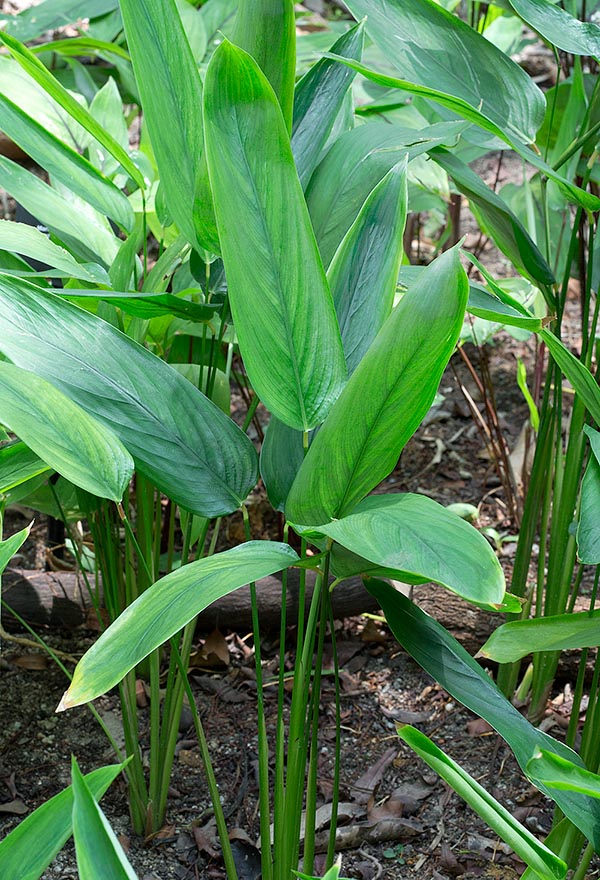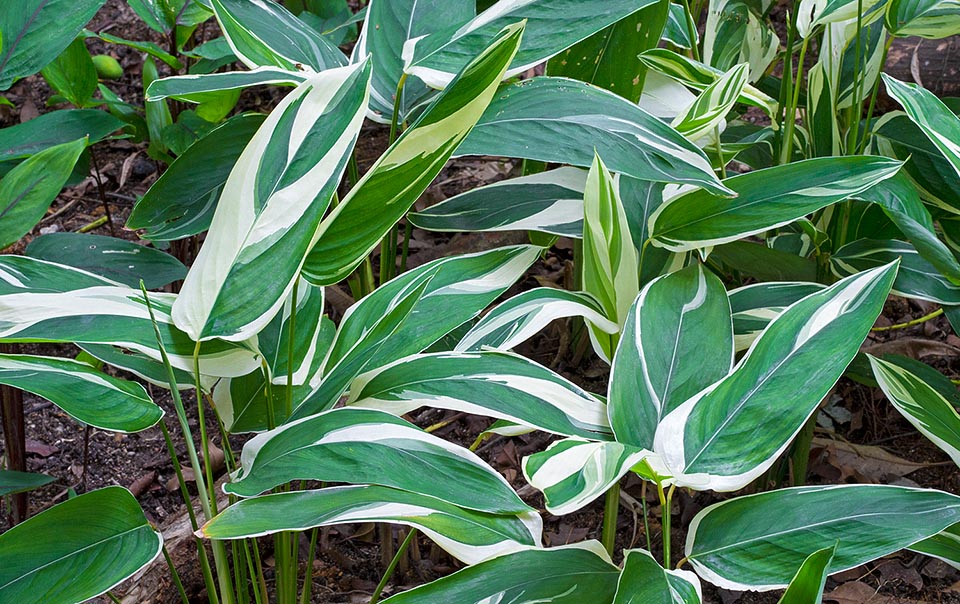Family : Marantaceae

Text © Pietro Puccio

English translation by Mario Beltramini

Native to tropical America, the Maranta arundinacea is a 30-150 cm perennial rhizomatous © G. Mazza
The name of the genus is dedicated to the Venetian physician and botanist Bartolomeo Maranta (1500-1571): the specific name is the Latin adjective “arundinaceus, a, um” = similar to a reed, from the Latin substantive “arundo” = reed.
Common names: arrowroot, Bermuda arrowroot, maranta, St. Vincent arrowroot, west Indian arrowroot (English); zhu yu (Chinese); uraro (Philipines); dictame, herbe aux flèches (French); kuzuukon (Japan); aruruttukkilangu, kookai neer, kuamu, kuva, palagunda, tavaksiri, tikkor (India); arus, garut, patat sagu (Indonesia); agutiguepe, araruta, araruta-comum, araruta-palmeira (Brazil); arroruz, arruruz, chuchute tamalera, guape, sagú, sagú de San Vicente, saguero, silú, tamalera, yerén (Spanish).
The Maranta arundinacea L. (1753) is a perennial rhizomatous herbaceous species, evergreen, 0,3-1,5 m tall, with fleshy rhizomes, 20-30 cm long and of 3,5-4 cm of diameter, covered by scales (vestigial leaves), and thin erect stems often ramified at the apex. The leaves, basal and cauline on a 3-20 cm long petiole, are ovate-lanceolate with pointed apex and entire margin, distichous, 5-30 cm long and 3-10 cm broad, of intense green colour, glossy above, more or less pubescent below. Dichotomous panicle terminal inflorescences carrying small bisexual flowers, subsessile or pedicellate, in groups of 2-3 subtended by green bracts 2-6 cm long. Persistent calyx with three equal sepals with pointed apex, about 1,5 cm long and 0,5 cm broad, of green colour. Arcuate tubular corolla, swollen at the base, of white colour, 1,2-2,5 cm long, trilobed with unequal lobes, about 1 cm long, and white petaloid staminodes longer than the corolla. The fruits are ovoid capsules of green colour suffused with reddish brown, about 0,7 cm long and of 0,5 cm of diameter, containing 1-3 oblong seeds, trigonal, of brown colour with whitish basal aril.
Usually it reproduces by division of rhizomes, provided of at least one bud, placed at a depth of 6-12 cm in fertile loam, loose and draining, maintained constantly humid, but without stagnations. The rhizomes are ready for havesting after one year.
Known since ancient times to the indigenous populations who used its rhizomes, rich of starch, as food and for healing purposes, in particular the mush obtained by them was renowned because healing the wounds caused by the poisoned arrows. In the early nineteenth century its cultivation has extended also outside the origin sites and presently the biggest producers are the Caribbean islands of St. Vincent and Jamaica, Brazil, and in south-eastern Asia the Philippines, India, Indonesia and Sri Lanka. The faecula extracted from the rhizomes, called arrowroot, distinguishes due to its characteristics of high digestibility and absence of gluten, hence suitable for the children, the convalescents, those presenting wheat intolerance and the coeliacs. It is utilized as thickener in sauces, soups, puddings, etc., as stabilizer in the homemade ice creams, for preparing cakes, biscuits and generally for bakery products in substitution of the wheat flour and also in the cosmetic industry.

Due to the fleshy rhizomes rich of starch, 20-30 cm long and even 4 cm broad, is often cultivated in the tropics. It produces a faecula, called arrowroat, easy to digest and without gluten. The variety with white streaked leaves, creates a spot of light in exotic gardens and reveals, with some care, an elegant indoor plant © Giuseppe Mazza
Are not finally to be underestimated its ornamental characteristics, in particular the white streaked variety, to utilize in group under big trees, where the climate allows so, or in pot in a luminous site with high atmospheric humidity and lowest temperatures not under the 16 °C; the rhizomes can be stored at lower temperatures, up to +6-8 °C.
Indoor the necessary humidity may be obtained with frequent nebulizations with non-calcareous water, in order to avoid unaestethic spots on the leaves, at ambient temperature, and placing the pot in a wide saucer filled with expanded clay or stone chips with a layer of water, not in direct contact with the bottom of the pot, so to create a humid microenvironment around the plant.
Synonyms: Maranta silvatica Roscoe (1807); Maranta sylvatica Roscoe ex Sm. (1812); Maranta indica Tussac (1813); Maranta ramosissima Wall. (1832); Maranta tessellata var. kegeljanii E.Morren (1875); Phrynium variegatum N.E.Br. (1886); Maranta arundinacea var. indica (Tussac) Petersen (1890); Maranta arundinacea var. variegata Ridl. (1891); Maranta arundinacea f. sylvestris Matuda (1951).
